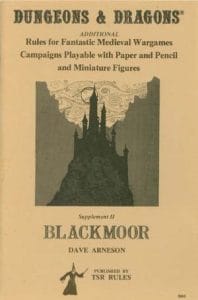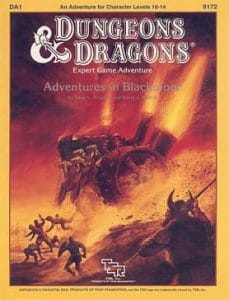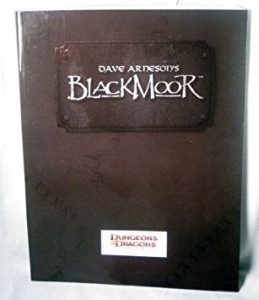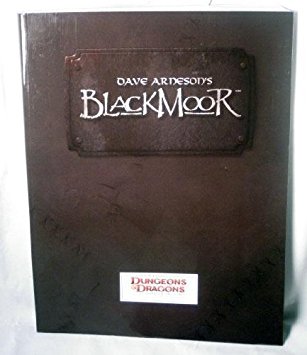
Early Dungeons and Dragons was very much a game in which things were figured out as they go. As such, a number of great campaign settings came and went – and were largely lost to time. One of these great campaign settings was Blackmoor, which was with D&D at the very beginning. Though ignored by all but the most hardcore fans now, it’s still a fantastic world to explore today.
History

Blackmoor spun out of miniature war games, particularly games like Chainmail and Braunstein. The initial game was far more based on real medieval Europe and real medieval combat, but Arneson’s experience with works like Lord of the Rings was quite apparent even from the start. It wouldn’t take long for Arneson to start applying the fantasy rules from Chainmail to this game.
Blackmoor was eventually shown to Gygax, which led to the eventual development of Dungeons and Dragons. Blackmoor would be run in tandem with Greyhawk for some time, though Dungeons and Dragons in general would start to eat up more and more of Arneson’s time. It is interesting to note that even in the early days, Blackmoor was largely run in tandem with Greyhawk – a relationship that would become more important much later in the run of the game.
Blackmoor is historically considered the second D&D setting, but it probably deserves a little more respect than that. In reality, it’s as much a part of the fabric of the game as Greyhawk. It’s quite possible that the game as players know it today wouldn’t exist without Blackmoor.
Publication
If you’re a fan of Blackmoor, you know that it hasn’t had the clearest publication history. In fact, it’s actually a little hard to track down the game through the more common channels. Most of this has to do with how long ago the last bits were published – it’s been a decade since there was new material. There is also the fact that almost anything having to do with Blackmoor is really part of D&D history.
Try my AI Tabletop RPG generators...and an extensive library of content!
Blackmoor has had the rather odd distinction of moving through several publishers in its lifetime. After the historical Blackmoor period under Arneson, it was published in several pre-D&D publications, was pushed out by TSR during the original run of the game, managed to become a related setting of Greyhawk, and eventually found its way to Zeitgeist games. It has been an independent game, a part of a larger line, a licensed game, and independent again during its long history.
Taking a look at the history of the game doesn’t just show you how difficult it can be to track down, though. It’s also a fantastic look at the history of Dungeons and Dragons and the development of table top role playing in general.
First Fantasy
First Fantasy is the publication that held much of the Blackmoor information before Dungeons and Dragons. It’s actually a great look at the growth of table top role playing and its players in the pre-D&D world, but it’s particularly interesting for those who want to see how one of the fathers of D&D managed to grow his own setting over time.
⚔️ Fantasy RPG Random Tables Books
Make life as a Gamemaster easier…
If you play Dungeons & Dragons, Pathfinder, or other fantasy RPGs, this
RPG random tables series
is packed with encounters, NPCs, treasure, and more. Available in eBook or print—either way, you’ll have a wealth of adventure ideas at your fingertips.
First Fantasy is where the bulk of the information about Blackmoor campaign setting came to life. Much like the Castle Greyhawk publications, it was very heavy on the lore surrounding the titular dungeon but somewhat more nebulous on the dungeon itself. Instead, it provided players and Dungeon Masters with much of what they needed to get a game going. It was an excellent approach to a still-fledgling type of game, one that would be heavily copied as Dungeons and Dragons got off the ground.
Though it’s not necessarily recommended that players seek out First Fantasy to play Blackmoor, it’s an incredible bit of game history in its own right. Most of what’s included here is republished material from before. It starts in 1972 and runs up through the games that Arneson ran at conventions. It’s a good place to look for material that is otherwise almost impossible to find, especially if you are interested in the history behind the game.
TSR Publication
Blackmoor began its association with Dungeons and Dragons in the same way as so many other settings – as a supplement for the main game itself. Published by TSR in 1975, it was actually the second D&D supplement to be published. It’s very hard to look at this version of Blackmoor as a game or as a setting in and of itself, largely because of all it didn’t contain. The early nature of the work means that it just doesn’t quite conform to what we would come to expect from similar products.
Dave Arneson wrote this booklet, but it’s actually rather hard to tell that. There’s virtually no information about the world in this initial supplement. Instead, most of what’s included here is rules. That’s actually quite handy for a world that hasn’t quite gotten a grip on D&D, but not so fantastic for those who already know how to play. Likewise, the lists of monsters and treasures would be very useful at the time but not terribly useful in the future.
The most interesting thing in the initial publication is the Temple of the Frog. This is one of the first D&D scenarios ever released, albeit one that is almost instantly overshadowed by what would come next. This is the only real look at the Blackmoor world, so it’s a bit of a treat for those who really want to get into the early days of the setting.
Module Series

Blackmoor was not an integral part of Advanced Dungeons and Dragons, the game that most people would generally think of as the “2.0” release of Dungeons and Dragons. Instead, it was tied to Basic Dungeons and Dragons, a separate game that was released around the same time. The decision to fork the product was probably one of the many reasons that TSR wouldn’t survive the 1990s and it is definitely one of the reasons why Blackmoor doesn’t get quite the same amount of press as some other settings.
Blackmoor’s story would continue through basic D&D as part of the DA series of modules. The present day of Basic Dungeons and Dragons was a world known as Mystara; Blackmoor was a kingdom that existed in Mystara’s distant past. In the DA series of modules, players would be thrown back in time to experience adventures in Blackmoor.
There were four modules in this setting, each of which helped to flesh out Blackmoor. Some of them were even based on Dave Arneson’s original notes, which lent a feel of authenticity to the whole thing. It was the first full exploration of the kingdom and the setting since Arneson’s departure.
While the fifth DA module was cancelled, Blackmoor would live on through Mystara. References to the setting would be made on a regular basis, even if the setting itself wouldn’t be seen again. It faded gracefully into the background Basic Dungeons and Dragons.
Other Formats
After Basic Dungeons and Dragons was discontinued and the world of Mystara brought to a close, Blackmoor was in a bit of a limbo. This wasn’t helped by the fact that there was some significant bad blood between TSR and Dave Arneson. TSR argued that Advanced Dungeons and Dragons was such a significantly different product from D&D that they no longer owed Arneson royalties, something that the latter would contest for years.
⚔️ Fantasy RPG Random Tables Books
Make life as a Gamemaster easier…
If you play Dungeons & Dragons, Pathfinder, or other fantasy RPGs, this
RPG random tables series
is packed with encounters, NPCs, treasure, and more. Available in eBook or print—either way, you’ll have a wealth of adventure ideas at your fingertips.
Fortunately, the story didn’t end with TSR. After financial mismanagement caused the company to go bankrupt, the intellectual property of Dungeons and Dragons became property of Wizards of the Coast. Wizards had a much more secure financial footing and, perhaps most importantly, wanted to restore the brand. That meant restoring a relationship with founders like Dave Arneson.
d20
One of the saving graces of many older supplements was Wizards of the Coast’s willingness to license out their properties to other developers. While Wizards didn’t seem to have much of an interest in adapting most of the early settings of D&D, they saw no problem making money off of those who did. They licensed out not only the settings, but also the d20 rule set – something that many publishers were more than happy to work with. Among these interested game makers was Dave Arneson himself.
Arneson had a fraught relationship with TSR, but his relationship with Wizards of the Coast seemed much smoother. While he wouldn’t be involved in D&D, he did work with Zeitgeist Games to produce Dave Arneson’s Blackmoor, a d20 game that captured both the mechanics and the spirit of the original game. It was one of the rare remakes of a classic setting that actually involved the original creative team and it was all the more fantastic because of that.
Like most of the d20 licensed products, Blackmoor existed in something of a liminal state for D&D fans. It wasn’t an official D&D product, but it could be played with D&D characters. It was an easy jump for those who had grown up with AD&D or even Basic D&D, but something that was a little outside of the range of those who had started with Wizards’ products.
Blackmoor was accompanied by a number of adventure guides, making the d20 experience something of a full-fledged reboot. It gave players a chance to play in the setting as Arneson had intended and helped bring to a close a chapter of the original Dungeons and Dragons experience. With no apparent ill will between Wizards and Arneson, the product was left to survive on its own merits.
4th Edition

Unfortunately for fans of Blackmoor, most of the old ideas that were brought back came from either the original game or the lineage of AD&D. Blackmoor, being a flagship setting of the other branch of the game, never really got the same kind of love that some other settings received.
All hope was not lost for fans of Blackmoor, though, because Zeitgeist was still publishing material. While it may not have been an official Wizards of the Coast product, Zeitgeist did manage to put out a campaign guide for 4th edition. These weren’t updated rules or much in the way of truly new material, but it was enough to bring back the name and the world for those who had originally loved the game.
Try my AI Tabletop RPG generators...and an extensive library of content!
Zeitgeist’s publication was relatively well-received among fans of the setting, but it wasn’t picked up by gamers at large. Finding the Blackmoor campaign guide could be something of a chore, but those who did manage to find it largely spoke positively of the experience. They found that it was well-translated to the new system and that much of what made Blackmoor special survived the translation.
There has been no real news of Blackmoor making the translation into 5th edition. The only good note is that gamers have become far more interested in the history of tabletop games recently and far more aware of the role that settings like Blackmoor played in early D&D. Hopefully, that will spark some interest in reviving at least parts of the setting.
The MMRPG
Perhaps due to its legacy as one of the oldest D&D settings, Blackmoor managed to become an icon in the community. Much like the other original setting, Greyhawk, Blackmoor received its own living campaign. While Blackmoor’s living campaign was not nearly as old as that of Greyhawk nor quite as well known, it nonetheless managed to keep the setting alive years after it had been forgotten by all but the most hardcore of gamers. The MMRPG was a very important part of the game.
The living campaign, called Dave Arneson’s Blackmoor: The MMRPG, would provide something that Wizards of the Coast and other game makers never really gave the setting – continuity. Zeitgeist Game’s version of the game would utilize D&D 3.5’s rules, thankfully bringing this classic setting back home for its last rule hurrah.
All good things must come to an end, and Blackmoor was no exception. Rather than adapting the game for the 4th Edition or trying to compete with the other D&D products out there, the MMRPG would end in 2009 at Megacon. There are undoubtedly fragmented groups that keep the campaign going in some way shape or form, but the official involvement with the MMRPG is now done.
Even with the publication of other products bearing the Blackmoor name, the end of the MMRPG felt like a definitive end of an era for the line. It was not just the last vestige of some of the most dedicated Blackmoor players – it was also a tacit admission that it was time to move on from the product in order to embrace new settings. Still, the fact that the MMRPG lasted for so long is a testament to how beloved the setting remained.
Legacy & Future
In many ways, the legacy of Blackmoor is table top role playing. Since it has been there since the beginning, almost everything else that followed D&D owes a huge debt to Blackmoor. Within the game itself, settings like Spelljammer probably wouldn’t have existed without some of the weirdness in the backstory of the game. In fact, it’s possible to say that many sci-fi elements probably owe a debt to the background of Blackmoor.
As for the future, it’s hard to tell. Blackmoor is a great setting to explore, but it’s increasingly become dated. Someone will certainly bring the name back in the future – it’s just a matter of how faithful that adaptation will be. For now, though. the more recent adaptations are very much worth playing.
What’s your experience with Dungeons and Dragons? Have you played Blackmoor? Are you interested in learning more about the history of Dungeons and Dragons? If so, make sure to visit us on the forums.










